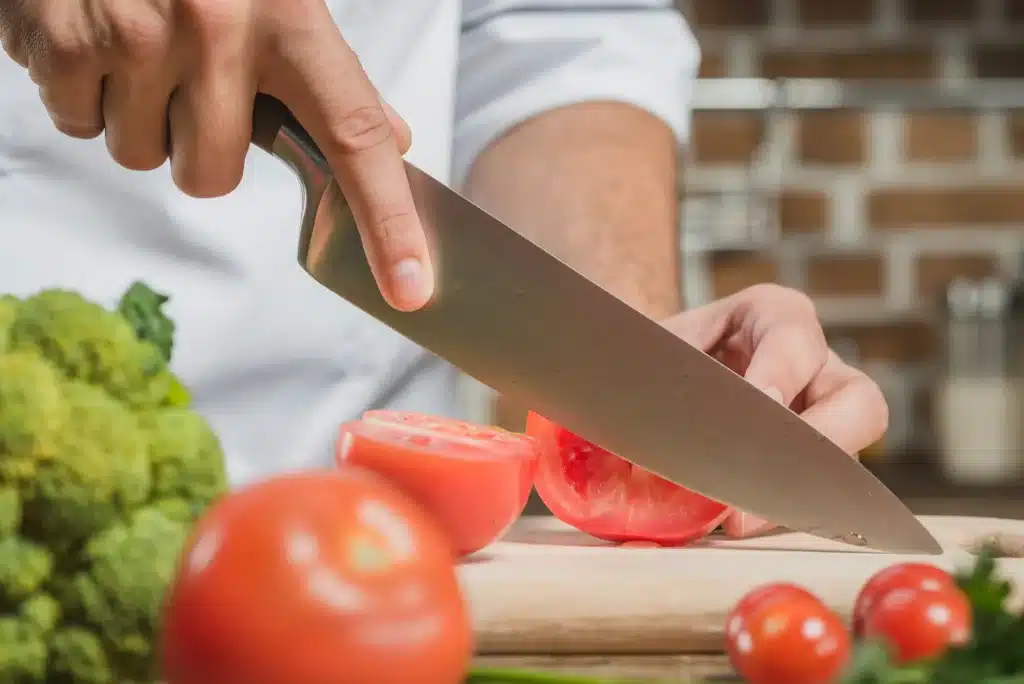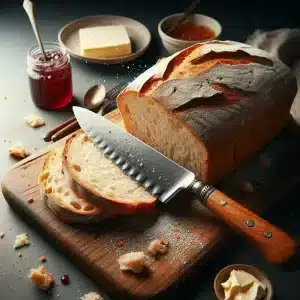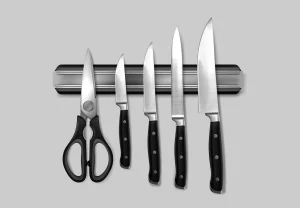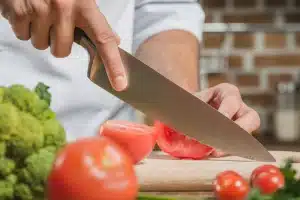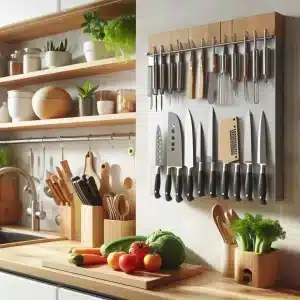Knowing how to properly use kitchen knives is essential for both home cooks and professional chefs. Whether you’re preparing vegetables, slicing meat, or chopping herbs, mastering knife skills will make cooking more efficient and enjoyable. In this guide, we will break down everything from basic grips to advanced cutting techniques, ensuring that you can handle your kitchen knives with confidence and precision.
Types of Kitchen Knives and Their Uses
Before diving into knife handling, it’s important to understand the variety of kitchen knives available. Each type serves a unique purpose, and using the right knife can make all the difference in your cooking.
- Chef’s Knife: The most versatile knife in any kitchen. Ideal for chopping, slicing, and dicing a variety of ingredients.
- Paring Knife: Perfect for small, delicate tasks such as peeling and trimming fruits and vegetables.
- Bread Knife: A long knife with a serrated edge, designed for slicing bread without crushing it.
- Boning Knife: Used for deboning meat and fish with its thin and flexible blade.
- Utility Knife: A general-purpose knife, smaller than a chef’s knife, useful for mid-sized cutting tasks.
Knowing when to use each knife helps ensure precision and safety in the kitchen.
How to Hold a Kitchen Knife: The Proper Grip
One of the most crucial aspects of knife safety and efficiency is learning how to grip the knife properly. A good grip ensures better control and reduces the risk of accidents.
Start by pinching the base of the blade with your thumb and index finger, while wrapping your other fingers around the handle. This “pinch grip” provides stability and control, making it easier to maneuver the knife for both heavy chopping and delicate slicing. A firm grip also prevents slippage during use, making cutting smoother and more efficient.
From my experience, mastering a strong, secure grip was the key to improving my knife skills. It feels more natural over time and allows for better precision when cutting tricky ingredients like slippery tomatoes or dense root vegetables.
The Guide Hand: Ensuring Safety While Cutting
Your non-dominant hand plays an equally important role when using kitchen knives. This is often referred to as the “guide hand” because it helps position the food and keeps it steady while you cut.
To use your guide hand correctly, curl your fingers inward, creating a claw-like shape. This allows you to protect your fingertips as you slice or chop. Keep the flat side of the knife blade against your knuckles as a guide while cutting. This technique not only helps you maintain uniform slices but also significantly reduces the risk of cutting yourself.
In my personal experience, using the guide hand effectively has made a huge difference. I was able to control the size of my slices and dice more accurately, which improved the overall presentation of my dishes. Plus, it greatly improved my safety when cutting tougher foods like squash or dense meats.
Cutting Techniques for Vegetables and Fruits
Vegetables and fruits are a staple in every kitchen, and knowing how to cut them properly can speed up meal preparation. Here are some common cutting techniques:
- Chopping: A fast, rough cut used for vegetables like carrots or celery. Hold the knife firmly and use a rocking motion to chop through the produce.
- Dicing: This technique results in small, uniform pieces. First, slice the vegetable into even strips, then cut those strips into cubes.
- Julienne: Create long, thin matchsticks by slicing vegetables like cucumbers or bell peppers. Start by cutting the vegetable into thin slabs, then stack and slice them into thin strips.
- Chiffonade: This is ideal for leafy greens or herbs. Stack the leaves, roll them tightly, and then slice thin ribbons.
Cutting fruits like apples or pineapples often requires extra care due to their slippery texture, so be sure to maintain a steady grip and cut slowly for precision.
Slicing Meat and Fish with Precision
Slicing meat and fish requires a different approach than cutting vegetables. The key is using long, smooth strokes with a sharp knife to avoid tearing the fibers of the meat.
- For Meat: Always slice against the grain to ensure tender pieces. This is especially important for tougher cuts like steak or brisket. Use a boning or chef’s knife depending on the size of the cut.
- For Fish: A sharp, thin-bladed knife like a fillet knife is ideal. For sashimi or delicate fish fillets, use slow, steady strokes to ensure smooth slices without shredding the flesh.
From my own experience, having a sharp knife when cutting meat is essential. A dull blade not only makes the task harder but can ruin the texture of the food. Slicing brisket or chicken breast was much easier when I sharpened my knives regularly.
Knife Care: How to Maintain Sharpness and Durability
Taking care of your knives ensures that they remain sharp and effective. Here are some key tips to maintain your kitchen knives:
- Sharpen Regularly: Use a sharpening stone or honing rod to maintain the edge of your knives. A sharp knife is safer than a dull one because it requires less force.
- Hand Wash Only: Avoid putting knives in the dishwasher, as this can dull the blade over time. Always hand wash and dry your knives immediately after use.
- Store Properly: Store your knives in a knife block or on a magnetic strip to prevent the blades from dulling or getting damaged.
- Use Cutting Boards: Always use wooden or plastic cutting boards, as harder surfaces like glass or stone can damage your knife’s edge.
Common Mistakes to Avoid When Using Kitchen Knives
Even seasoned cooks can make mistakes when handling knives. Avoid these common pitfalls:
- Using the Wrong Knife: Always choose the right knife for the task. Using a paring knife for heavy chopping or a chef’s knife for delicate tasks can lead to accidents or poor results.
- Cutting on Hard Surfaces: As mentioned, avoid using glass or marble cutting boards, which can dull your knives quickly.
- Not Keeping Knives Sharp: Dull knives require more force and increase the risk of accidents. Regular sharpening is essential.
- Incorrect Grip: Failing to use the pinch grip or neglecting to use your guide hand can reduce your control and increase the risk of injury.
Advanced Cutting Techniques for Home Chefs
Once you’ve mastered the basics, you can move on to more advanced knife skills:
- Rocking Chop: For herbs or garlic, use a rocking motion where the tip of the knife remains on the cutting board, and you move the blade up and down.
- Rolling Cuts: Used for irregularly shaped vegetables like carrots. After each cut, rotate the vegetable a quarter turn to create evenly sized pieces.
- Butterflying Meat: This technique involves slicing meat thinly without cutting all the way through, allowing it to open like a book. It’s great for stuffing chicken breasts or preparing meat for grilling.
FAQs About Kitchen Knives
1. How often should I sharpen my kitchen knives?
Sharpening every 2-3 months should suffice for home use, but it depends on how frequently you use your knives. Honing after each use will keep the blade in good shape between sharpening.
2. What’s the best way to hold a knife?
The best grip is the “pinch grip,” where you pinch the blade with your thumb and index finger while your other fingers wrap around the handle. This provides control and precision.
3. What should I do if my knife slips while cutting?
Stop immediately, reset your grip, and ensure that the surface is dry. A good grip and a dry cutting surface are essential for knife safety.
4. Can I put my knives in the dishwasher?
No, always hand wash your knives. The heat and harsh detergents in dishwashers can dull and damage the blade.
Final Tips for Mastering the Use of Kitchen Knives
Mastering the use of kitchen knives is a skill that improves over time with practice. Remember to keep a steady grip, utilize your guide hand for safe cutting, and always use the correct knife for the task. By maintaining your knives well and practicing different cutting techniques, you’ll not only cook more efficiently but also elevate the presentation and precision of your dishes.
With these tips, you’ll be well on your way to becoming a knife expert in the kitchen. Happy cooking!

